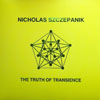 After last year's acclaimed Please Stop Loving Me and the Ante Algo Azul subscription series, Szczepanik has almost simultaneously put out his first and second vinyl releases. While the two albums could hardly be more different from each other, both carry the composer's careful attention to detail and creation of beautiful, sparse music.
After last year's acclaimed Please Stop Loving Me and the Ante Algo Azul subscription series, Szczepanik has almost simultaneously put out his first and second vinyl releases. While the two albums could hardly be more different from each other, both carry the composer's careful attention to detail and creation of beautiful, sparse music.
The duality of these albums is striking:from the stark differences in artwork to overall presentations of the albums, they sit at the end of two extremes.From the 10 track We Make Life Sad, which has a distinctly nostalgic picture of two children on the front, to the sparse green and yellow design on The Truth of Transience, which almost resembles a vintage geometry textbook, and features two side-long pieces.
The albums follow similar patterns on the actual sonic content as well, with We Make Life Sad focusing on shorter, hazy, static-drenched pensive pieces, while The Truth of Transience is clean, almost sterile, but not off-putting.Much of the former is enshrouded in a warm, nostalgic static that perfectly channel old, but treasured memories.Most of the pieces are rather quiet, with "Consciousness" and "Long Gone" leaning more into the louder end of the spectrum with what could be old 78s from someone’s attic played loudly."Her Last Breath" also goes a bit more into dissonance, but with a rich, slow repetition that never feels too noisy.
"Another Screened World" feels most in line with Szczepanik’s previous work, with shimmering slow passages echoing and reverberating with a nostalgic melancholy."Over Your Dead Body," besides its uncharacteristically morbid title, is another piece of sustained droning tones, and with the organ-like sounds, has a darker, almost funeral quality to it.
Both "Totemic Vignette" and "Nostalgia" use individual notes more than long, drawn out tones, and what at least sounds like a guitar in the former and piano in the latter.In addition to the more complicated structures, they also are bathed in a gloriously captivating static texture, with the latter especially emphasizing the noisier moments towards its conclusion.
samples:

In contrast, The Truth of Transience is a more detached, almost clinical affair.The A side's slow, bellowing opening of cold, sparse tones make this immediately obvious.Nowhere does that reflection on past memories vibe come through here.The droning tones rise and fall, eventually becoming bassier and finally put through a rhythmic tremolo until coming to an abrupt end.
Flipped over, the second part goes for the low-end undercurrent right away, slowly introducing a fuzzed out layer of noise above the rhythmic pulse.Although it is pretty sparse in its construction, there is a clear lushness to the sound that has a multitude of subtleties within.Later on the higher end buzzing elements get slightly more spiny and acidic, ending the piece, once again abruptly, on a dissonant note.
The duality of fuzzy nostalgia and clinical drone are both things that Szczepanik has used in previous works, but here they arepushed to the extremes.Because of this, neither album is better than the other, since they’re both so different, but great in their own ways.Not too many artists can work in these polarizing conditions and succeed in both, but Szczepanik has done just that.
samples:
- The Truth of Transience (Side A, Excerpt 1)
- The Truth of Transience (Side A, Excerpt 2)
- The Truth of Transience (Side B)
 
Read More

